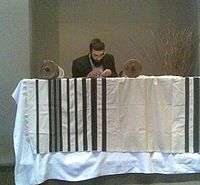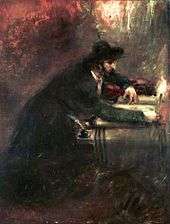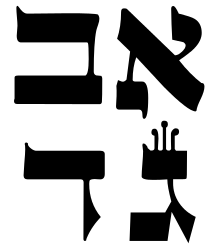Sofer
A sofer, sopher, sofer SeTaM, or sofer ST"M (Heb: "scribe", סופר סת״ם; plural of sofer is soferim סופרים; female: soferet) is a Jewish scribe who can transcribe sifrei Torah (Torah scrolls), tefillin (phylacteries), and mezuzot (ST"M, סת״ם, is an abbreviation of these three terms), of the Five Megillot and other religious writings.

By simple definition, a sofer is a copyist, but the religious role in Judaism is much more. Besides sifrei Torah, tefillin, and mezuzot, scribes are necessary to write the Five Megillot (scrolls of the Song of Songs, Book of Ruth, Book of Esther, Ecclesiastes, and Book of Lamentations), Nevi'im (the books of the prophets, used for reading the haftarah), and for gittin, divorce documents. Also, many scribes function as calligraphers—writing functional documents such as ketubot "marriage contracts", or ornamental and artistic renditions of religious texts, which do not require any scribal qualifications, and to which the rules on lettering and parchment specifications do not apply.
The major halakha pertaining to sofrut, the practice of scribal arts, is in the Talmud in the tractate "Maseket Sofrim". In the Torah's 613 commandments, the second to last[1] is that every Jew should write a sefer Torah in his lifetime (Deuteronomy 31:19).
Qualifications and education
A sofer must be religiously observant, of good character, and knowledgeable about the laws concerning sofrut. It is a common misconception that one has to be a rabbi in order to become a sofer, which is not required by Jewish law.
People who want to become ritual scribes usually learn from another expert scribe by undergoing Shimush (Apprenticeship), since it would be impossible for someone to be a scribe without any actual practice. The hardest part about learning to be a sofer is not the calligraphy, but, rather, remembering the thousands of laws that apply to sifrei Torah, tefillin, mezuzot, and all the other texts that are written on parchment.
Some people who want to become ritual scribes learn at the Vaad Mishmereth STaM, with the option of receiving a certificate. (This is an international organization whose goal is to protect the halachic and artistic integrity of the scribal arts. It is located in Jerusalem and Bnei Brak in Israel, as well as in Brooklyn, New York, United States.) Certification of this sort is not a halachic requirement, nor does it necessarily guarantee the quality of a particular sofer's work. This process does however ensure that a certified sofer has received the proper education and is a recognized expert in the field of sofrut.
Texts teaching sofrut

The main texts from which soferim learn the scribal art include the Keset Ha-Sofer, Chasdey David, Mishnah Berurah (24-45), Mishneh Torah (Hilchot Tefillin u'Mezuzah v'Sefer Torah, Hilchot Tzitzit), Mishnat Hasofer, Mishnat Sofrim, Likkut Sifrey Stam.[2]
Women and sofrut
Forming the basis for the discussion of women becoming soferim, Talmud Gittin 45b states, "Sifrei Torah, tefillin and mezuzot written by a heretic, a star-worshipper, a slave, a woman, a minor, a Cuthean, or an apostate Jew, are unfit for ritual use."[3] The rulings on mezuzot and tefillin are virtually undisputed among those who hold to the Talmud. While Arba'ah Turim does not include women in its list of those ineligible to write Sifrei Torah, some see this as proof that women are permitted to write a sefer Torah.[4] However, today, virtually all Orthodox (both Modern and Ultra) authorities contest the idea that a woman is permitted to write a sefer Torah. Yet, women are permitted to inscribe Ketubot (marriage contracts), STaM not intended for ritual use, and other writings of sofrut beyond simple STaM. In 2003, Canadian Aviel Barclay became the world's first known traditionally trained woman sofer.[5][6]
Among non-Orthodox Jews, women have written Torah scrolls since the early 2000s. In 2007 Jen Taylor Friedman, a British woman, became the first woman sofer to scribe a sefer Torah.[7] In 2010, the first sefer Torah scribed by a group of six women (from Brazil, Canada, Israel, and the United States) was completed;[8] this was known as the Women's Torah Project.[9] Since then, other women have written Torah scrolls.[9][10][11][12][13][14] As of 2014, there are an estimated 50 women sofers in the world.[15]
Documents written by scribes
Besides Torah scrolls, tefillin, and mezuzot, scribes are also necessary for the writing of the Five Megillot (scrolls of the Song of Songs, Book of Ruth, Book of Esther, Ecclesiastes, and Book of Lamentations) and Nevi'im (the books of the prophets, used for reading the haftarah), and for gittin (divorce documents). In some communities, especially Chaim Kanievsky's community in Bnei Brak, soferim also write the other books of the Bible, such as Psalms or the Book of Ezra. This was promoted in 19th-century Jerusalem by Rabbi Shemuel Shelomo Boyarski.
Calligraphy and lettering

There are many rules concerning the proper formation of letters that must be adhered to if a written text is to be deemed religiously valid.[16] The Ashkenazi, Sefardi, Chabad (Lubavitch), and Mizrahi Jews each have their own script for forming the letters, though the same rules apply throughout the text. Generally, regarding sifrei Torah, none of these groups would consider that these differences would render a Torah posul (ritually unfit or invalid).
The documents must be written on properly prepared parchment or vellum known as klaf.
Many scribes also function as calligraphers—writing functional documents like ketubot, or ornamental and artistic renditions of religious texts—which do not require any scribal qualifications, and to which the rules on lettering and parchment specifications do not apply.
References
- 82nd of the 613 commandments as enumerated by Rashi, and the second to final as it occurs in the text of the Torah, Book of Deuteronomy 31:19, the final being in Deuteronomy 32:38
- "sources". Sofer.co.uk. Archived from the original on 2016-06-18. Retrieved 2015-05-17.
- https://web.archive.org/web/20091019133505/http://www.geniza.net/ritual/women.shtml. Archived from the original on October 19, 2009. Retrieved February 18, 2016. Missing or empty
|title=(help) - Tur, Orah Hayyim 271
- Alice Lowenstein (2005-06-03). "A Female Scribe's Trailblazing Effort". Forward.com. Retrieved 2015-05-17.
- "Simchat Torah with a Soferet's Torah | Jewish Women's Archive". Jwablog.jwa.org. 2006-10-13. Retrieved 2015-05-17.
- Leah Hochbaum Rosner (2007-09-12). "As New Year Dawns, Jewish Women Mark Milestones". Forward.com. Retrieved 2015-05-17.
- Fishkoff, Sue (2010-10-15). "Women's Torah dedicated in Seattle". Jta.org. Retrieved 2015-05-17.
- "Julie Seltzer, a female Torah scribe from San Francisco, contributed to the first Torah scroll to be written by a group of women". Jweekly.com. 2010-10-21. Retrieved 2015-05-17.
- "The CJM | the Contemporary Jewish Museum". Archived from the original on April 8, 2011. Retrieved October 30, 2011.
- "A Torah Scribe Pushes the Parchment Ceiling". The New York Times. Retrieved 2015-05-17.
- "CJM to celebrate end of groundbreaking Torah project". Jweekly.com. 2011-03-31. Retrieved 2015-05-17.
- Spiro, Amy. "Torah, she wrote - Jewish World". Jpost.com. Retrieved 2015-05-17.
- "Archived copy". Archived from the original on April 14, 2013. Retrieved October 30, 2011.CS1 maint: archived copy as title (link)
- Jeff Kunerth (2014-08-23). "– Female Jewish scribe helps keep tradition alive". Pressherald.com. Retrieved 2015-05-17.
- Some details on letters, with animations Archived May 10, 2016, at the Wayback Machine
